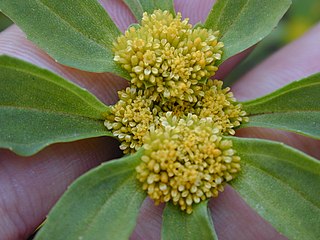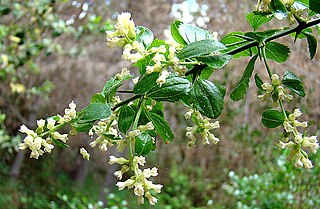
Celtis is a genus of about 60–70 species of deciduous trees, commonly known as hackberries or nettle trees, widespread in warm temperate regions of the Northern Hemisphere. The genus is part of the extended hemp family (Cannabaceae).

Austromuellera is a genus of only two known species of medium-sized trees, constituting part of the plant family Proteaceae. They are both endemic to three restricted areas of the wet tropics rainforests of north-eastern Queensland, Australia. The genus was named in 1930 in honour of Ferdinand von Mueller by Cyril T. White. They lie within the tribe Banksieae within the family Proteaceae, their closest relatives the genera Musgravea and Banksia.

Musgravea is a genus of rainforest tree from north-eastern Queensland.

The Grevilleoideae are a subfamily of the flowering plant family Proteaceae. Mainly restricted to the Southern Hemisphere, it contains around 46 genera and about 950 species. Genera include Banksia, Grevillea, and Macadamia.

Moehringia trinervia, commonly known as apetalous sandwort or three-nerved sandwort, is a herbaceous plant of the family Caryophyllaceae. A native of Eurasia, it has been introduced into North America.
Matudaea trinervia is a species of plant in the family Hamamelidaceae. It is endemic to Mexico.
Matudaea is a genus of plant in family Hamamelidaceae.

Moehringia is a genus of flowering plants in the family Caryophyllaceae. Members of this genus and of some other genera in Caryophyllaceae are commonly called sandworts. They are found only in the north temperate zone. The genus Moehringia was first formally named by Carl Linnaeus in 1753. It is named after Paul Möhring (1710–1791).
Retanilla trinervia is a species of actinorhizal plant within the family Rhamnaceae; this dicotyledon flora is a shrub or small tree. R. trinervia is notable for its ability to fix nitrogen. This species mainly occurs in the near coastal forests and arid shrubland of Chile. Example occurrences are found in the mountains of central Chile; for example, it occurs in the La Campana National Park in association with Acacia caven and Jubaea chilensis. as well as other proximate areas of central Chile.

Astelia is a genus of flowering plants in the recently named family Asteliaceae. They are rhizomatous tufted perennials native to various islands in the Pacific, Indian, and South Atlantic Oceans, as well as to Australia and to the southernmost tip of South America. A significant number of the known species are endemic to New Zealand. The species generally grow in forests, swamps and amongst low alpine vegetation; occasionally they are epiphytic.

Flaveria trinervia is a species of flowering plant in the family Asteraceae known by the common names clustered yellowtops, speedyweed, and yellow twinstem. It is native to parts of the Americas, including the southeastern and southwestern United States, most of the Bahamas, Mexico, Belize, and parts of the Caribbean, especially Cuba, Cayman Islands, Jamaica, Hispaniola, Puerto Rico and Barbados. It is also known in many other places as an introduced species and often a noxious weed, such as in Hawaii.

Oedera is a genus of African flowering plants in the tribe Gnaphalieae within the family Asteraceae. The genus is named in honor of the Danish botanist Georg Christian Oeder.

Leptospermum trinervium, commonly known as flaky-barked tea-tree, slender tea-tree or paperbark tree, is a species of shrub or small tree that is endemic to eastern Australia. It has papery bark that is shed in thin, flaking layers, narrow elliptic to broadly egg-shaped leaves with the narrower at the base, white flowers and silky-hairy fruit that falls from the plant when mature.
Silky oak is a common name for Grevillea robusta.

Drosera trinervia is a species in the carnivorous plant genus Drosera that is endemic to the Cape Provinces of South Africa. It was first described by Kurt Polycarp Joachim Sprengel in his 1820 work Neue Entdeckungen im ganzen Umfang der Pflanzenkunde.
Flaveria australasica is an Australian plant species of yellowtops within the family Asteraceae. It has been found in New South Wales, Queensland, South Australia, Western Australia, and Northern Territory.
Sebastiania trinervia is a species of flowering plant in the family Euphorbiaceae. It was originally described as Gymnanthes trinerviaMüll.Arg. in 1863. It is native to Bahia, Brazil.

Pultenaea blakelyi, commonly known as Blakely's bush-pea, is a species of flowering plant in the family Fabaceae and is endemic to south-eastern continental Australia. It is an erect shrub with sharply-pointed, narrow elliptic to egg-shaped leaves and yellow to orange flowers in open clusters in leaf axils or at the ends of branches.

Retanilla is a genus of flowering plants in the family Rhamnaceae, native to Chile, Peru, and Argentina. The species in this genus are actinorhizal plants.
Austromuellera valida is a species of rainforest tree in the protea family that is endemic to north-eastern Queensland, Australia. It was first formally described by Bernard Hyland in 1999 in the series Flora of Australia.












